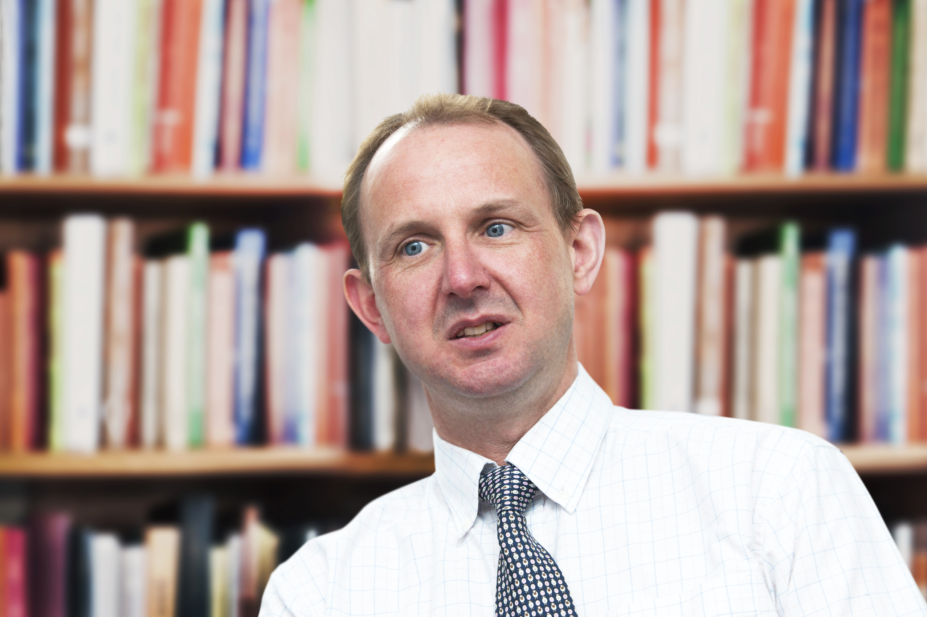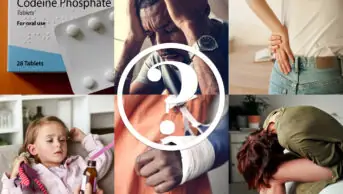
Charlie Milligan
Pain expert Roger Knaggs is sitting among shelves fit to burst with formularies and academic texts, and a desk covered in documents.
These texts are not just for show — they symbolise the considered, evidence-based approach he takes to his work, which has enabled this associate professor in clinical pharmacy practice to have a voice that extends far beyond his office, which is tucked away on the third floor of the School of Pharmacy at the University of Nottingham.
In January 2019, Knaggs was one of four pharmacists appointed as a member of the Advisory Council on the Misuse of Drugs (ACMD), the high-profile body that advises ministers on drugs policy.
He is also the first pharmacist vice-president of the British Pain Society, and he sits in a number of groups, including the Care Quality Commission’s working group on opioids and the National Institute of Health and Care Excellence’s guideline development group for chronic pain.
The Pharmaceutical Journal speaks to him at an interesting time for pain medicine, with several reviews underway of the use of opioid medicines in the UK, and a mere six months after medical cannabis was legalised. He speaks softly, but you are left in no doubt about the veracity of his opinions.
What research are you currently focused on?
One project with Keele and Southampton universities will develop a package of care to support clinical pharmacists in GP practices to manage patients taking opioids and encourage them to reduce what they’re taking. To develop the intervention will take 12—18 months, and then another 18 months doing feasibility testing before full-scale transfer.
Opioids may work for a short period, even for some long-term pain, but then they appear to be less effective and the dose is increased
What are the biggest issues when it comes to the misuse of drugs in the UK?
Most of my expertise is around prescribed or over-the-counter (OTC) medicines of which we need to find a balance between ensuring appropriate use, but minimising harms and side effects. That is quite a difficult balance to achieve, particularly with opioids.
Opioids may work for a short period, even for some long-term pain, but when they appear to be less effective, the dose is increased to improve their effectiveness — that’s when you get into a vicious cycle of the drugs becoming less and less effective over time.
Should the UK follow the lead of countries such as Australia in removing codeine from over-the-counter sales?
It’s an extreme measure. The issue comes when people start taking opioids for longer periods than they’re intended to be used. Realistically, if you’re needing them for longer periods then it should be supervised by your GP. The problem is that their OTC availability doesn’t stop you from walking from one pharmacy to the next to obtain more and more — it’s very hard to police.
What perspective do you bring to the Advisory Council on the Misuse of Drugs?
Much of the emphasis of the ACMD is around illicit substances — if a pharmacist wasn’t there, OTC and prescription issues probably would not cross the other council members’ minds.
During my interview to join the AMCD, I had to give a five-minute presentation. I talked about the misuse of prescription drugs, but also about having to get our heads around cannabis.
Cannabis is going to occupy a lot of ACMD time for a whole host of reasons — we are living in the middle of a social experiment
Cannabis is definitely going to occupy a lot of ACMD time for a whole host of reasons — we are living, globally, in the middle of a social experiment. There have been initiatives in lots of different countries to look at increasing availability for medical purposes, but each country’s approach has been slightly different.
Overall, I would say, the United States — if it’s not careful — is in danger of moving from an opioid crisis to a cannabis crisis. There are some areas where people were being prescribed opioids, but, because they can’t have them anymore, have moved onto cannabis. There are other areas where, while use remains technically illegal, they’ve come up with loopholes to allow a small amount of prescribing.
Nowhere so far has really evaluated what the impact these changes to classification and availability have had, and that’s something that the Home Office has tasked us with looking at.
How does the council make its recommendations?
We’re advisory, but we are also independent. We rely on evidence and its interpretation, to come to our own conclusions. If there isn’t any, we need to say so. In these policy situations, it’s better to say “there is no evidence on which to base a decision”, rather than have a position that is not based on evidence.
There is a range of sources of information that we would look at for medical cannabis: deaths, diversion, whether availability has increased for people it is not intended for, and the number of seizures of either home-cultivated substances or imports through customs.
At the moment, not a lot of medical cannabis has been prescribed, so it is still very early days. The latest request from the Home Office is to provide an outline framework by the end of 2019, with the aim of having an initial view by the end of 2020.
What is your view on medical cannabis?
In terms of pain, the evidence for benefit is very small. If you look at the number needed to treat, you need to treat 20–25 people for one person to have good pain relief, but you only need to treat 6 patients for one to experience harm.
Until there are medical cannabis products that are more familiar, the situation may well still remain
From a prescribing perspective there’s also a big question around dose. I’m not surprised there haven’t been that many prescriptions because the clinicians who may wish to prescribe it just don’t know what the right product is for that person. Until there are products that are more familiar, the situation may well still remain.
There have been suggestions that medical cannabis could be used to reduce opioid dependency — what are your thoughts on this?
If you can create cannabinoids that modulate the endogenous cannabinoid system but don’t come with the psychoactive effects, then they could have lots of therapeutic uses. Cannabidiol (CBD) certainly has less psychoactive activity compared with tetrahydrocannabinol, but at the moment we don’t have any medicines that are purely CBD.
Where CBD is sitting, largely as a food supplement, is not helpful. If manufacturers of any cannabis-related products would like it to be used for medical use, they should be prepared to go through the normal development process and there should be trials of efficacy — at the moment a lot of the evidence is either anecdotal or very poorly designed.
With pain medicines becoming increasingly restricted, what other options should we be moving towards?
There is an increasing realisation of the limited effectiveness of medicines in the management of chronic pain and a move towards more activity-based approaches and self-management of symptoms. With opioids, the best way to use them is to keep the dose low but use them intermittently — reserving them for flares or exacerbations.
People need to understand the differences between acute pain and chronic pain. With chronic pain, a lot of the issues are around abnormal functioning within the nervous system rather than anything structural, so active approaches and exercise are good treatments — although trying to convince people with chronic pain to exercise can be really difficult.
For people who are presenting initially, we need to look at the importance of psychological factors and how mood and anxiety can influence the experience of pain. There is a role for psychological treatments, such as cognitive behaviour therapy (CBT) or newer forms of CBT (e.g. acceptance commitment therapy), with medicines forming a part of that overall package.
People who have had pain for a long time very often become ‘medicalised’ in the way they think about their symptoms. They may have been taking medicines that have become ineffective over time but are anxious about stopping or reducing them because they think their symptoms will get worse.
It’s about exploring these concerns, starting with their understanding of their condition, what makes their symptoms worse and what makes their symptoms easier to manage.
What do you hope will come out of the government’s “landmark review” to address prescription drug addiction and dependency in England, and what do you think is the best approach?
Increased awareness of the problem. The key will be to increase funding for people who have developed misuse or dependence with prescription medicines.
There needs to be better service provision and there needs to be more coordination of care between physical and psychiatric services. Very often, there is a mixture of physical symptoms and psychological problems and, at the moment, the number of addiction services that are prepared to treat patients with an addiction to prescription drugs is relatively small.
I hope that there is greater consideration of how these are linked, and some practical suggestions around how these patients are best managed and who the best person to be seeing them is.
A recent series published in the
The Lancet
highlighted the impact of post-operative opioid prescribing — what are your thoughts?
This is another area we do need to be very mindful of. Hospitals want to get people mobile and discharged more quickly — which is entirely right — but, at the same time we know that this has increased the number of people who are discharged with substantial amounts of strong opioids.
Discharge information from hospitals should be very clear about the length of time that it would be expected for somebody to need a strong opioid
There needs to be much better communication at the interface. First of all, the patient should be told: “You will be given this on discharge but you should only need it for so long,” so they have an idea that it is going to be time limited. Likewise, the discharge information from hospital should be very clear about the length of time that would be expected for somebody to need a strong opioid which should then be communicated to primary care.
What about the work being carried out by the Medicines and Healthcare products Regulatory Agency working group looking at the risks and benefits of opioid medicines?
It’s going to be interesting to see what these different reviews bring up.
There are so many people with fingers in this pie; it’s really important that there is consistent messaging and that people are saying the same sort of thing and not contradicting each other — otherwise it could be a disaster.
Roger Knaggs, specialist pain pharmacist and member of the Advisory Council on the Misuse of Drugs


